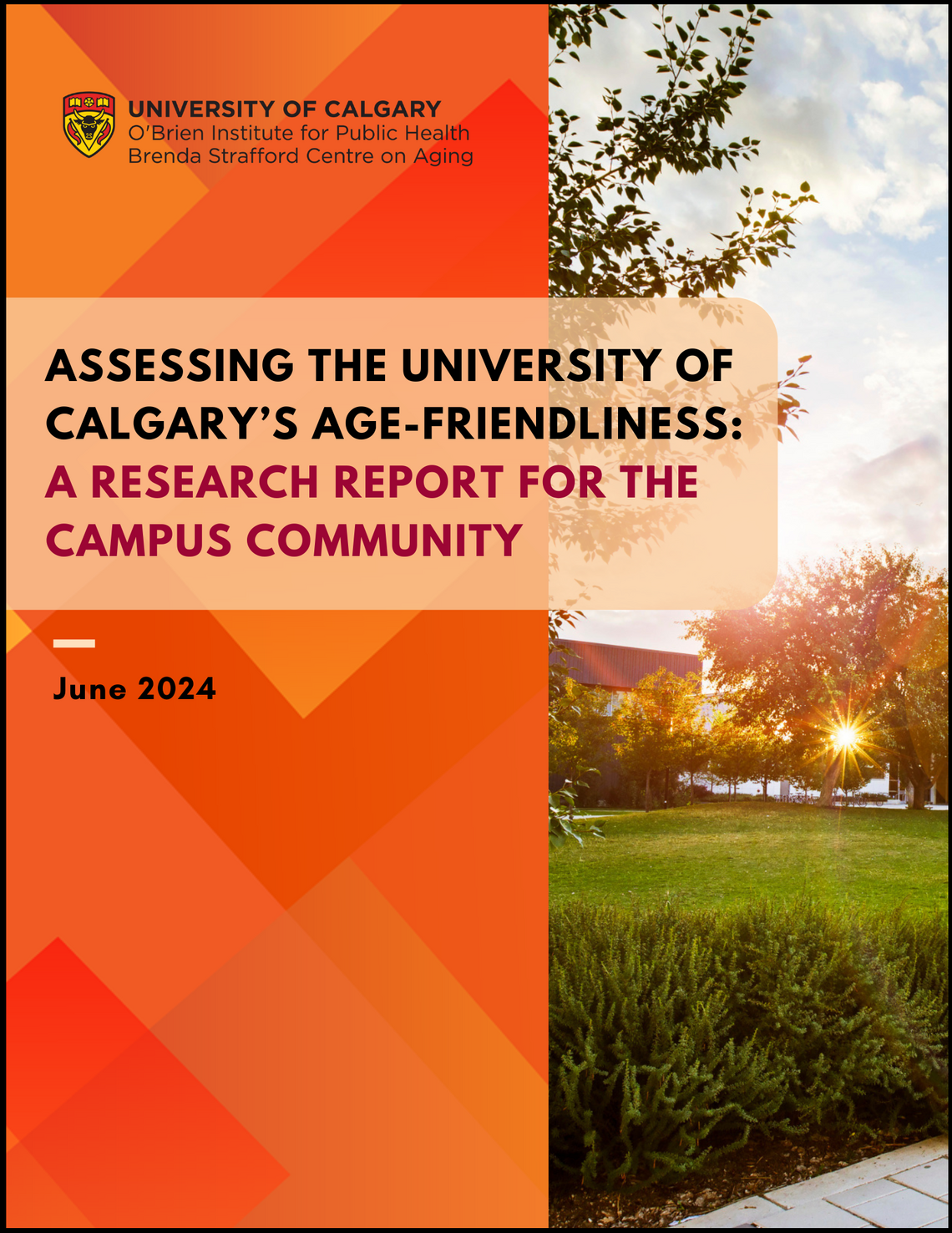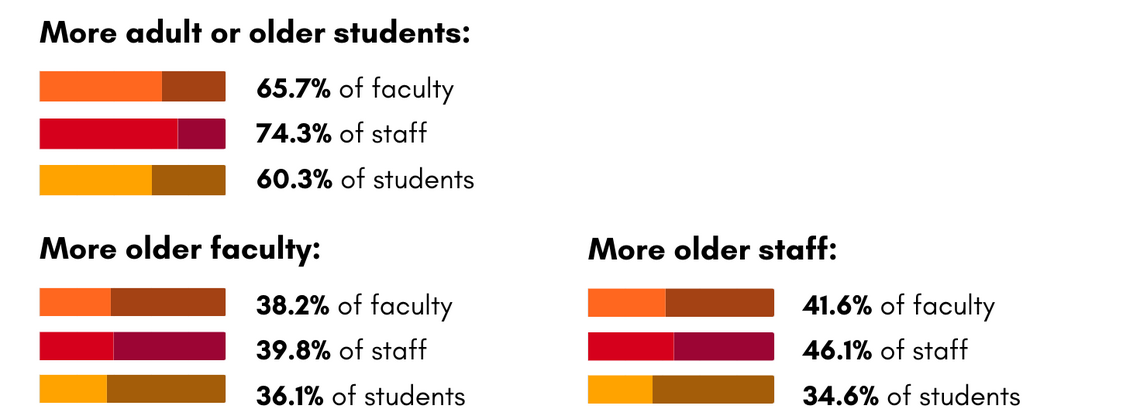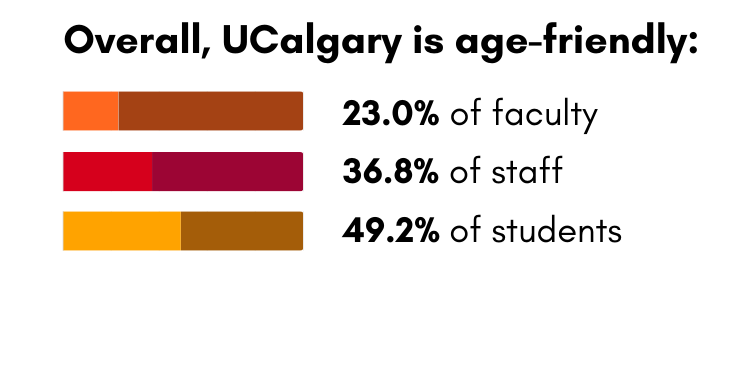Assessing UCalgary’s Age-Friendliness
The Age-Friendly University (AFU) movement encourages post-secondary institutions to be more inclusive of older adults and more engaged in aging-related issues. To understand how age-friendly UCalgary is, the Centre on Aging conducted an assessment between July 2022 and March 2023.
The assessment consisted of two parts. First, an inventory was completed by 10 administrators to identify existing age-friendly practices and environmental features across campus. Second, a survey was completed by 1,953 faculty, staff, and students to understand their awareness, perceptions, and beliefs about age-friendliness and age-inclusivity at UCalgary.
The results provide a snapshot of the University's strengths and gaps, helping to guide future efforts toward a more age-inclusive campus. Below you will find the full research report, a one-page summary, and key findings from the assessment.

Report
The research report provides detailed information about the methods and results of the assessment.

Summary
The one-page research summary provides high-level information about the methods and results of the assessment.
Results
Awareness of AFU Status
Despite UCalgary's membership in the AFU Global Network, few survey participants were aware of the University's AFU status.
Familiarity with an AFU
About one-third of participants indicated that they were slightly or moderately familiar with the concept of an AFU, with few being very or extremely familiar.
Age Diversity
Most participants believed that having more adult and older students at the University would be beneficial, but fewer participants perceived the benefits of having more older faculty and staff.
Note: Adult students are those aged 21+ at the start of their undergraduate program. Older students are those aged 50+.

Ageism
The majority of participants felt that ageism directed towards older adults was a serious problem in society, but less than one-third felt it was a problem at the University.

From the open-ended survey question:
Participants who shared additional insights about UCalgary's age-friendliness by responding to the open-ended question at the end of the survey expressed that facilitated intergenerational activities would foster a more age-inclusive campus community and society.
I hope that more can be done to improve intergenerational relations in society and that UCalgary can be at the forefront of this change. It seems like societal norms favor people in certain stages of life, and that undermines a person's potential in their early and later stages.
Staff member
Teaching and Learning
- Approximately one-quarter of faculty (26.4%) and one-third of students (35.6%) reported that courses are available on topics related to aging and older adults.
- About two-thirds of faculty (69.7%) and students (70.4%) were unsure whether available courses on aging covered the diverse experiences of older adults.
- Many faculty (39.9%) thought there was potential for more collaboration on aging-related courses, but few (3.9%) indicated there were opportunities to receive support in preparing these courses.
- Less than one-third of faculty (30.3%) and one-quarter of students (23.1%) thought there were opportunities for older faculty and students to serve as mentors or tutors.


Research
- Two-thirds of faculty (66.9%) indicated that they were available to informally discuss aging research with other faculty members, but less than a fifth were encouraged to collaborate across faculties and departments on aging research.
- A low percentage of students reported that they were encouraged to research issues related to aging (15.9%) and attend research presentations on aging topics (13.5%).
- One-eighth of faculty (12.4%) perceived research across disciplines to regularly include the perspectives of older adults.
- About one-third of faculty (36.0%) and one-fifth of students (19.5%) were aware of aging-related research publicized to the campus community.
Supports and Services
- Approximately half of faculty (49.4%) and staff (52.0%) were aware of available information on how to seek leave time for caregiving, but less than a quarter felt they had choices in scheduling.
- Students commented on a lack of campus supports and infrastructure for those with caregiving responsibilities, such as adequate academic accommodations and childcare centres.
- Few faculty (15.7%) felt the University promoted professional intergenerational relationships.
- Half of students (53.3%) reported they had opportunities to interact with older community members through campus activities outside their classes.

Physical Environment
Many of the age-friendly environmental features assessed are present at the University, though less than half of participants were aware of these features except for those that tend to be more noticeable or commonly used.
Overall Age-Friendliness
Most age-friendly campus practices and environmental features assessed are present at the University. Despite this, only one-quarter to half of participants perceived UCalgary to be age-friendly.

Key Takeaways
UCalgary is moderately age-friendly overall. However, most survey participants had limited knowledge of an AFU and were generally unaware of existing age-friendly campus practices and environmental features. The inventory and survey highlighted both strengths and gaps, with the most significant gaps found in:
- Teaching and learning: Supporting the integration of aging topics into existing courses and the development of new courses on aging, fostering intergenerational interactions in the classroom, creating two-way mentoring opportunities for older and younger students;
- Research: Prioritizing research on aging, developing and promoting aging-related research opportunities for faculty and students, publicizing aging-related research;
- Human resources: Providing two-way mentoring opportunities for older and younger faculty, supporting the workplace needs of older employees, publicly recognizing the contributions of longstanding and retired employees;
- Student affairs: Creating age-diverse recruitment materials;
- Services and resources: Offering resources and supports for employees and students who are caregivers;
- Outreach and engagement: Forming relationships with older adults and community organizations to advance aging-related education and research, and supporting the participation of older community members in campus activities.
